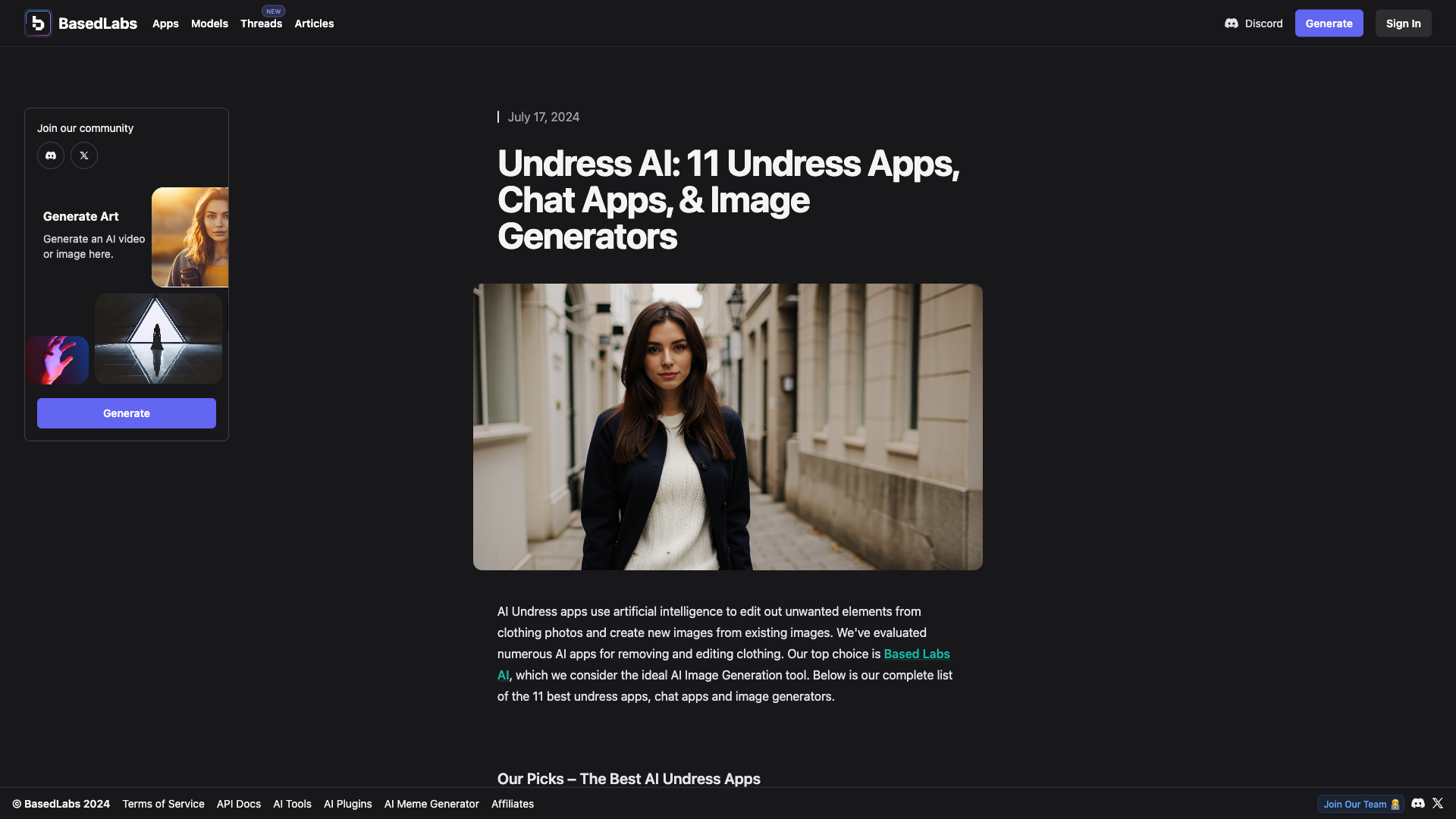Hey there, folks! So, let's dive straight into the heart of the matter. AI free undress is a phrase that's been making waves across digital platforms, sparking both curiosity and concern. Imagine technology so advanced that it can digitally remove clothing from images or videos. Sounds like something out of a sci-fi movie, right? But guess what? It's here, and it's raising some serious questions about privacy, ethics, and the future of AI. In this article, we're going to break it down for you—what it is, how it works, and why it matters.
Now, before you get all worked up, let's set the record straight. The technology behind AI free undress isn't inherently bad—it's just a tool. Like any other tool, it can be used for good or bad purposes. Think about Photoshop—while it’s amazing for editing photos, it’s also been criticized for promoting unrealistic beauty standards. Similarly, AI free undress has its pros and cons, and understanding both sides of the coin is crucial.
So, whether you're here because you're curious, concerned, or just plain confused, you're in the right place. We’re going to deep dive into everything you need to know about this controversial tech, including its potential impact on society and what it means for the future. Let's get started!
What Exactly is AI Free Undress?
Alright, so let’s break it down. AI free undress refers to the use of artificial intelligence algorithms to digitally remove clothing from images or videos. It’s not just about editing pictures; it’s about using sophisticated machine learning models to analyze and manipulate visual data. The technology works by identifying patterns in clothing textures, shadows, and body shapes to create realistic-looking images where the clothing appears to be removed.
Here's the kicker: this tech isn’t just limited to still images. Some advanced versions can even work on videos, which takes things to a whole new level. Now, before you start panicking, let’s clarify something important. The quality of the results can vary greatly depending on the software and the skill of the person using it. Some tools are more accurate than others, but none are perfect.
How Does AI Free Undress Work?
Let’s get technical for a moment. At its core, AI free undress relies on deep learning models, specifically convolutional neural networks (CNNs). These networks are trained on vast datasets of images to recognize patterns and make predictions. When you feed an image into the system, the AI analyzes the pixels, identifies the clothing, and then generates a new image where the clothing is digitally removed.
- James Frazier Profiles Law Golden Bough Insights
- Explore Bi Dax With Marco Russo Experts Articles Insights
Here’s a quick breakdown of the process:
- Data Collection: The AI is trained on thousands, sometimes millions, of images to learn how different types of clothing appear on various body shapes.
- Pattern Recognition: Once trained, the AI can identify clothing in new images and predict what’s underneath.
- Image Manipulation: The final step involves generating a new image where the clothing is replaced with skin or other textures.
It’s fascinating, isn’t it? But with great power comes great responsibility, and that’s where things get tricky.
Why is AI Free Undress Controversial?
Now, here’s the big question: why is everyone so worked up about AI free undress? Well, there are several reasons. First and foremost, it raises serious concerns about privacy. Imagine someone taking a photo of you in public and then using AI to digitally undress you. Sounds creepy, right? That’s exactly why this tech has sparked outrage among privacy advocates.
Another issue is consent. In many cases, the people whose images are being manipulated haven’t given permission for their photos to be used in this way. This can lead to misuse, especially in the context of revenge porn or other forms of harassment. Plus, there’s the ethical dilemma of whether it’s even okay to develop such technology in the first place.
Privacy Concerns and Legal Implications
Let’s talk about the legal side of things. In many countries, there are laws against non-consensual sharing of intimate images, commonly known as revenge porn. However, these laws often don’t cover the use of AI to create fake images. That’s a loophole that needs to be addressed, and lawmakers are starting to take notice.
For example, in the United States, some states have introduced legislation specifically targeting deepfake technology, which includes AI free undress. But enforcement is still a challenge, especially when the tech is evolving faster than the law can keep up.
Is AI Free Undress Always Harmful?
Now, here’s the thing: not everyone sees AI free undress as a negative. Some people argue that it has legitimate uses, such as in the fashion industry or for educational purposes. For instance, designers could use the tech to visualize how clothing fits on different body types without needing physical models. Similarly, medical professionals might use it for research or training purposes.
However, these potential benefits don’t outweigh the risks for many people. The potential for misuse is simply too great, and that’s why the tech remains controversial. It’s all about finding a balance between innovation and responsibility.
Possible Positive Applications
Let’s explore some of the positive ways AI free undress could be used:
- Fashion Design: As mentioned earlier, designers could use the tech to experiment with different styles and fits.
- Medical Research: Doctors could use it to study body anatomy or simulate surgeries.
- Art and Entertainment: Artists might use the tech to create new forms of digital art or enhance visual effects in movies.
But again, these applications need to be approached with caution to avoid unintended consequences.
Who’s Behind AI Free Undress?
So, who’s developing this tech? Well, it’s not just one company or group. There are several organizations and individuals working on AI free undress, both in academia and the private sector. Some of these projects are open-source, meaning anyone can access and use the code. Others are proprietary, developed by companies looking to monetize the technology.
One notable example is a company called DeepNude, which made headlines in 2019 for creating an app that could digitally undress women in photos. The app was quickly taken down after facing backlash, but the technology itself continues to evolve.
DeepNude: A Case Study
DeepNude is a prime example of how AI free undress can go wrong. The app was designed to remove clothing from photos of women, but it only worked on female subjects, which raised questions about gender bias. Additionally, the app didn’t require consent from the individuals in the photos, which sparked outrage from users and privacy advocates alike.
After facing intense criticism, the developers behind DeepNude decided to shut down the app. But the damage was already done, and the incident highlighted the need for stricter regulations and ethical guidelines in AI development.
How Can We Regulate AI Free Undress?
Okay, so we’ve talked about the problems. Now, let’s talk about solutions. How can we regulate AI free undress to prevent misuse? One approach is through legislation. Governments can pass laws that specifically address the use of AI in creating fake or manipulated images. These laws could include penalties for non-consensual use and require companies to implement safeguards.
Another approach is through industry self-regulation. Tech companies could establish ethical guidelines and best practices for developing and deploying AI technologies. This would involve transparency, accountability, and user consent.
Challenges in Regulation
Of course, regulating AI free undress isn’t easy. There are several challenges to consider:
- Technological Complexity: AI is constantly evolving, making it difficult to keep regulations up to date.
- Global Nature: The internet doesn’t respect borders, so international cooperation is essential.
- Enforcement: Even with laws in place, enforcement can be tricky, especially when the tech is used anonymously.
Despite these challenges, it’s crucial that we find ways to regulate AI free undress to protect people’s privacy and dignity.
What Can You Do to Protect Yourself?
So, what can you do to protect yourself from the potential misuse of AI free undress? Here are a few tips:
- Be Careful What You Share: Think twice before posting photos or videos online, especially if they could be used maliciously.
- Use Strong Privacy Settings: Make sure your social media accounts are set to private and limit who can see your posts.
- Stay Informed: Keep up with the latest developments in AI and privacy laws so you know what to watch out for.
Remember, knowledge is power. The more you understand about AI free undress and its potential risks, the better equipped you’ll be to protect yourself.
The Future of AI Free Undress
So, where do we go from here? The future of AI free undress is uncertain, but one thing is clear: the conversation isn’t going away anytime soon. As AI technology continues to advance, we’ll need to find ways to balance innovation with responsibility. That means developing ethical guidelines, implementing effective regulations, and fostering public awareness.
Ultimately, the future of AI free undress will depend on how we choose to use it. Will it be a tool for creativity and progress, or a weapon for harassment and exploitation? That’s up to us.
Conclusion
Alright, folks, that’s a wrap. We’ve covered a lot of ground today, from what AI free undress is to why it’s controversial and what we can do about it. Here’s a quick recap:
- AI free undress is a technology that uses AI to digitally remove clothing from images or videos.
- It raises serious concerns about privacy, consent, and ethics.
- There are potential positive applications, but the risks of misuse are significant.
- Regulation is needed to protect people’s privacy and dignity.
So, what do you think? Is AI free undress a necessary evil, or should it be banned altogether? Let us know in the comments below, and don’t forget to share this article with your friends and family. Together, we can start a conversation about the future of AI and how we want to shape it.
Table of Contents
- What Exactly is AI Free Undress?
- How Does AI Free Undress Work?
- Why is AI Free Undress Controversial?
- Privacy Concerns and Legal Implications
- Is AI Free Undress Always Harmful?
- Possible Positive Applications
- Who’s Behind AI Free Undress?
- DeepNude: A Case Study
- How Can We Regulate AI Free Undress?
- Challenges in Regulation
- What Can You Do to Protect Yourself?
- The Future of AI Free Undress


